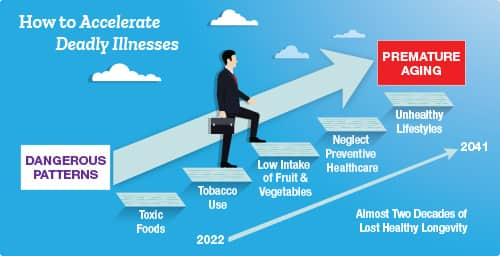Life Extension Magazine.
The British government collects medical data on its citizens better than most other countries.
In March 2021, the Office of National Statistics published a report showing that British men in the upper economic category live in good health an astounding 19 more years than men in the lowest group.1
Women in this upper category enjoy 19.3 more years in good health.
Overall life expectancy for men in the upper economic class is 9.4 years longer compared to the lowest category.
This is not the first report showing improvements in healthy longevity in those who take steps to reduce their disease risks.
Reasons for more healthy life years in better-educated British citizens include less tobacco use, more nutritious diets, and access to private health care.2,3
Another data set finds those in the lower socioeconomic category have high relative incidences of premature deaths from coronary heart disease.4
This premature clogging of arteries can be attributed to excessive amounts of fried foods and saturated fat in the diet, not enough fruits and vegetables, spiraling obesity rates, and tobacco use.4-6
These losses of healthy life years are not always attributable to socioeconomic status. A large swath of the general public engages in risky behaviors that threaten to ignite a new epidemic of cardiovascular disorders.
A study published by JAMA in April 2022 found mortality to be 169% higher after age 65 in Americans having no financial assets compared to those with at least $300,000 (in 1995 dollars).7
Additional financial assets beyond $500,000 were not associated with lower mortality, implying that great wealth is not required to enjoy more healthy life years.
This editorial explores healthy longevity practices that are relevant worldwide, including the United States.
Disparity Among British Citizens
Studies of human population groups have long uncovered disparities in healthy longevity that are not attributed to race or geographic location.
A report issued in March 2021 by the British Office of National Statistics highlights the wide disparities as follows:1
- Males living in the most deprived areas of England can expect to live 19 years less in "good" health compared with those in the least deprived.
- The healthy longevity gap for females in the most deprived areas of Britain is 19.3 years.
The authors of this report point out that the life expectancy variation at birth is worsening across England.
Women in the most deprived areas of England experienced a decline in life expectancy at birth, while women in the least deprived areas had an increase in life expectancy at birth.
Those living in the most economically deprived areas spend almost two decades less in good health than their counterparts in the least deprived areas.
And these disparities occur in a country (United Kingdom) that provides free universal health care.
The encouraging news is that many of these lost healthy life years can be recovered in all socioeconomic classes.
Health Disparities in the United States
A study published in the May 27, 2020 issue of JAMA Cardiology looked at heart disease variations among socioeconomic classes in the United States.8
Individuals residing in low socioeconomic-status areas had twice the incidence of coronary artery blockage and heart attacks compared with higher socioeconomic areas.
Even after accounting for traditional risk factors such as tobacco use, body weight, LDL, blood pressure, and type II diabetes, those residing in low socio-economic areas still had an elevated risk of early coronary heart disease.
Interestingly, just 40% of heart disease events in the low socioeconomic group were attributable to the traditional risk factors mentioned in the above paragraph.
This leaves 60% of coronary disease incidences "attributable to other factors associated with low socioeconomic status."
The authors of this JAMA Cardiology study suggest that increased stress, less access to nutritious foods, and inadequate medical care are among the reasons for the high rate of coronary artery disease in low socioeconomic groups. The authors also point out healthier lifestyle choices practiced in higher socioeconomic status groups that reduce cardiovascular risks.
I partially concur with these assumptions but am concerned about other risk factors that are neglected by individuals in all socioeconomic classes.
These risk factors include overconsumption of sugars, excess calorie intake, and health negligence that is prevalent in modern societies…including by some readers of Life Extension® Magazine.
Rising Obesity Prevalence
Excess body fat leads to the development of diabetes, heart disease, liver failure, osteoarthritis, and certain cancers. 9
England has some of the worst upticks in obesity prevalence compared with the rest of Europe.
A 2017 review article stated that obesity trends in most European countries increased by 10%-40% over a 10-year period.9
During this same period, obesity prevalence in England more than doubled (over 100% higher).9
According to a 2021 study, more deaths in England and Scotland since 2014 may be due to excess body weight than are caused by cigarette smoking.10
Smoking trends in England have declined in recent decades while obesity prevalence has sharply increased.10
A similar situation has occurred in the United States.
Worsening Trends in Scotland
The British Medical Journal (2014) reported a 43% decline in coronary disease death rates from 2000 to 2010 in Scotland.13
This decrease occurred because of improved prevention and treatment and was evenly consistent across socioeconomic classes.
The authors then point out that rising rates of obesity and type II diabetes are offsetting some of these benefits, and that diabetes prevalence worsened in the lowest socioeconomic classes.
Move forward to a report published by the British Heart Foundation in January 2022. Cardiovascular deaths are more than three-times higher for people (under age 75) in Glasgow, Scotland, than in other areas of England.14
The map copied on this page shows areas of Britain that have higher cardiovascular death rates. What it does not reveal are the wide disparities that exist within cities like Glasgow, where those in lower socioeconomic classes suffer more cardiovascular events at younger ages.
Heart Failure Cases Soar Globally
A study published in February 2021 by the European Society of Cardiology looked at 195 countries and found the number of people with heart failure nearly doubled between 1990 and 2017.11
The authors of this study said the rising prevalence of heart failure in the low, low-middle, and middle socioeconomic demographic-index countries "is driven by a surge of risk factors such as hypertension, diabetes mellitus, obesity, smoking, and other unhealthy lifestyles."
Sudden death from heart failure plummeted by 44% from 1995-2014 in the United States.12
Increasing obesity prevalence is causing hard-fought reductions in cardiovascular disorders to go in reverse.
Dietary Supplement Use in Britain
Unlike other countries that restrict dietary supplements, Britain has long permitted the sale of high-potency nutrients without costly registration requirements.
This policy provides British citizens access to supplements that Americans have long enjoyed.
The problem is supplements in Britain are more expensive and subject to an additional value-added tax.
Access to supplements can benefit echelons of British society that can afford them but is of little help to lower classes that cannot even afford fresh fruits and vegetables.
The British government is recognizing this dilemma.
In 2021, all British citizens were offered free vitamin D supplements.
Regrettably, each capsule of these "free supplements" contains only 10 mcg (400 IU) of vitamin D. This dose is woefully inadequate compared to the 5,000 IU to 8,000 IU of vitamin D many people need to achieve optimal blood levels.
Unhealthy Behavior Across All Economic Classes
In presentations I give about emerging rejuvenation therapies, I remind the group to not forget the fundamentals of healthy longevity.
Some of our supporters engage in aggressive experimental regeneration efforts but neglect the basics of disease prevention (such as optimizing blood pressure).
The slide at the bottom of this page outlines some of the reasons why low socioeconomic British citizens have 19 fewer years of good health.
Yet many of us who can avoid these unhealthy behaviors nonetheless engage in too many of them. The penalty I’ve observed is vascular disorders that were largely preventable.
Smokers spend about $3,000 each year on cigarettes, plus pay higher medical/life insurance premiums, plus lose work productivity from illnesses.
When smokers complain they cannot afford fresh fruits and vegetables, the easier-said-than-done solution is obvious, i.e., discontinue the tobacco use.
JAMA Study Corroborates British Findings
On April 8, 2022, the Journal of the American Medical Association (JAMA) published findings from a study that evaluated mortality over an 18-year period that found:7
- After age 65, mortality in those with no assets was 2.69-times higher (hazard ratio) relative to those with at least $300,000 of assets (in 1995 dollars).
- Based on this, those with no assets have only a 40% estimated probability of surviving from age 65 to age 85, while 71% of those in the $300,000 asset category survived from age 65 to 85.
- Additional wealth greater than $500,000 was not associated with lower mortality.
- As it related to tobacco use, after adjustment for confounding variables, the estimated probability of surviving from age 65 to age 85 was only 33% for current smokers compared to 70% for those who never smoked. Said differently, this study found that smoking is associated with sharply higher mortality independent of one’s socioeconomic status.
My observations over the past 45 years are that higher net worth individuals do not always take care of themselves better than those with relatively few resources.
The slide on the previous page titled, "How to Accelerate Deadly Illnesses," shows how to shorten healthy longevity no matter what financial class you fit into.
Stop Premature Aging!
As I turn age 68, a significant number of my highly educated friends (attorneys and CPAs my age) suffer from chronic illness or have died from preventable causes.
Despite their high incomes, many failed to engage in the basics of preventative medicine.
The data sets presented in this article should motivate more readers to improve their behavioral patterns so they can enjoy more years in great health.
For longer life,
William Faloon
References
- Available at: https://www.ons.gov.uk/peoplepopulationandcommunity/healthandsocialcare/healthinequalities/bulletins/healthstatelifeexpectanciesbyindexofmultipledeprivationimd/2017to2019. Accessed July 12, 2021.
- Available at: https://www.theguardian.com/society/2022/mar/02/private-healthcare-boom-two-tier-system-uk. Accessed July 12, 2022.
- Available at: https://www.kingsfund.org.uk/publications/whats-happening-life-expectancy-england. Accessed July 7, 2022.
- O’Flaherty M, Bishop J, Redpath A, et al. Coronary heart disease mortality among young adults in Scotland in relation to social inequalities: time trend study. BMJ. 2009 Jul 14;339:b2613.
- Available at: https://www.health.harvard.edu/heart-health/how-much-will-fried-foods-harm-your-heart. Accessed July 11, 2022.
- Sacks FM, Lichtenstein AH, Wu JHY, et al. Dietary Fats and Cardiovascular Disease: A Presidential Advisory From the American Heart Association. Circulation. 2017 Jul 18;136(3):e1-e23.
- Glei DA, Lee C, Weinstein M. Assessment of Mortality Disparities by Wealth Relative to Other Measures of Socioeconomic Status Among US Adults. JAMA Netw Open. 2022 Apr 1;5(4):e226547.
- Hamad R, Penko J, Kazi DS, et al. Association of Low Socioeconomic Status With Premature Coronary Heart Disease in US Adults. JAMA Cardiol. 2020 Aug 1;5(8):899-908.
- Agha M, Agha R. The rising prevalence of obesity: part A: impact on public health. Int J Surg Oncol (N Y). 2017 Aug;2(7):e17.
- Ho FK, Celis-Morales C, Petermann-Rocha F, et al. Changes over 15 years in the contribution of adiposity and smoking to deaths in England and Scotland. BMC Public Health. 2021 Feb 11;21(1):169.
- Bragazzi NL, Zhong W, Shu J, et al. Burden of heart failure and underlying causes in 195 countries and territories from 1990 to 2017. Eur J Prev Cardiol. 2021 Dec 29;28(15):1682-90.
- Shen L, Jhund PS, Petrie MC, et al. Declining Risk of Sudden Death in Heart Failure. N Engl J Med. 2017 Jul 6;377(1):41-51.
- Hotchkiss JW, Davies CA, Dundas R, et al. Explaining trends in Scottish coronary heart disease mortality between 2000 and 2010 using IMPACTSEC model: retrospective analysis using routine data. BMJ. 2014 Feb 6;348:g1088.
- Available at: https://www.bhf.org.uk/-/media/files/research/heart-statistics/bhf-cvd-statistics---uk-factsheet.pdf. Accessed July 12, 2022.







